|
Chapter Nine
LANDING ON
PLANET EARTH
Landing on Planet Earth....The Symbol of the Seven Dots....
The Seven Stations....
"We have set foot only on the
Moon, and have probed only the planets
closest to us with unmanned craft. Beyond our relatively close
neighbors, both interplanetary and outer space still outside the
reach of even small scanning craft. But the Nefilimís
own planet,
with its vast orbit, has served as travelling observatory, taking
them through the orbits of all the outer planets and enabling them
to observe at first hand most of the solar system.
"No wonder, then, that when they landed on Earth, a good deal of the
knowledge they brought with them concerned astronomy and celestial
mathematics. The Nefilim, "Gods of Heaven" upon
Earth, taught Man to
look up unto the heavens - just as Yahweh urged Abraham to do.
Mr. Sitchin explains the reason for so many findings dealing with
symbols of constellations, planets and the relationship with the
"gods."
"What was the meaning of the symbol of the seven dots? Many clues
leave no doubt that it was the celestial symbol of Enlil.
"....The planet of
Enlil was Earth. Earth - to the
Nefilim - was the
seventh planet.
"....Our astronomy is geared to the notion that Earth is the third
planet - which, indeed, it is if one begins the count from the
center of our system, the Sun.
"But to someone nearing our solar system from the outside, the first
planet to be encountered would be Pluto, the second
Neptune, the
third Uranus - not Earth. Fourth would be Saturn; fifth
Jupiter;
sixth Mars.
"And Earth would be seventh."
"No one but
the Nefilim, travelling to Earth past Pluto, Neptune,
Uranus, Saturn, Jupiter, and Mars could have considered Earth "the
seventh."
"....Earth is not the only planet whose numerical position in the
solar system was represented symbolically. Ample evidence shows that
Venus was depicted as an eight-pointed star:
Venus is the eighth
planet, following Earth, when counted from the outside. The
eight-pointed star also stood for the goddess Ishtar, whose planet
was Venus.
"Many cylinder seals and other graphic relics depict
Mars as the
sixth planet. A cylinder seal shows the god associated with Mars
(originally Nergal, then Nabu), seated on a throne under a
six-pointed "star" as his symbol. Other symbols on the seal show the
Sun, much in the same manner we would depict it today; the Moon; and
the cross, symbol of the "Planet of Crossing," the
Twelfth Planet.
Mr. Sitchin explains the central religious events of ancient
Mesopotamia, and the finding of Mardukís seven stations.
THE SEVEN STATIONS:
Paraphrased:
The first station of Marduk, "House of Holiness."
The second station, "Where the Field Separates."
The third station, (the name partly mutilated) had an epithet "Lord
of Poured-Out Fire."
The fourth station, "Holy Place of Destinies."
The fifth station, "The Roadway."
The sixth station, "Travellerís Ship."
The seventh station, "House of building life on Earth."
On each station Marduk had an epithet, and the epithet of the
seventh house was "God of the House of Resting."
"It is our contention that the
seven stations in the procession of Marduk represented the space trip of the
Nefilim from their planet
to Earth:
-
that the first "station," the "House of Bright Waters," (Mardukís
epithet) represented the passage by Pluto
-
the second ("Where the
Field Separates") was Neptune
-
the third, Uranus
-
the fourth - a
place of celestial storms - Saturn
-
the fifth, where "The Roadway"
became clear, "where the shepherds word appears," (Mardukís
epithet), was Jupiter
-
the sixth, where the journey switched to "The Travellersí Ship," was
Mars
"And the seventh station was Earth - the end of the journey, where
Marduk provided "House of Resting" (the godís "house of building
life on Earth").
Aeronautics and Space
Administration of the Nefilim....
THE CRAFT....
"How did the "Aeronautics and Space Administration" of the
Nefilim
view the solar system in terms of the space flight to Earth?
"Logically - and in fact - they viewed the system in two parts. The
one zone of concern was the zone of flight, which embraced the space
occupied by the seven planets extending from Pluto to Earth. The
second group, beyond the zone of navigation, was made of four
celestial bodies - Moon, Venus, Mercury and the Sun. In astronomy
and divine genealogy, the two groups were considered separate.
"....In the skies, each group was supposed to stay in its celestial
zone, and the Sumerians assumed that there was a "celestial bar"
keeping the two groups (of "Four" and "Seven")
apart.
"The Four were located in a celestial zone the Sumerians termed
GIR.HE.A ("celestial waters where rockets are confused"),
MU.HE
("confusion of spacecraft"), or UL.HE ("band of confusion"). These
puzzling terms make sense once we realize that the Nefilim
considered the heavens of the solar system in terms of their space
travel.
"Only recently, the engineers of Comsat (Communications Satellite
Corporation) discovered that the Sun and Moon "trick"
satellites and
"shut them off." Earth satellites could be "confused" by showers of
particles of solar flares or by changes in the Moonís reflection of
infrared rays. The Nefilim, too, were aware that rocket ships or
"spacecraft entered a "zone of confusion" once they passed Earth and
neared Venus, Mercury, and the Sun.
"....First to be encountered by
the Nefilim approaching the solar
system was Pluto. The Mesopotamian lists name this planet
SHU.PA
("supervisor of the SHU"), the planet that guards the approach to
the Supreme Part of the solar system.
"....Next to the
Shupa was IRU ("loop"). At
Neptune, the spacecraft
of the Nefilim probably commenced its wide curve or "loop" toward
its final target. Another list named the planet, HUM.BA, which
connotes "swampland vegetation." When we probe Neptune someday, will
we discover that its persistent association with waters is due to
the watery swamps the Nefilim saw upon it?
"Uranus was called
Kakkab Shanamma ("planet which is the double").
Uranus is truly the twin of Neptune in size and appearance. A
Sumerian list calls it EN.TI.MASH.SIG ("planet of bright greenish
life"). Is Uranus, too, a planet on which swampy vegetation
abounded?
"Beyond Uranus looms Saturn, a giant planet (nearly ten times
Earthís size) distinguished by its rings, which extend more than
twice as far out as the planetís diameter. Armed with a tremendous
gravitational pull and the mysterious rings, Saturn must have posed
many dangers to the Nefilim and their spacecraft. This may well
explain why they called the fourth planet TAR.GALLU ("the
great
destroyer"). Throughout the ancient Near East, the planet
represented the punisher of the unjust. Were these names expressions
of fear or references to actual space accidents?
Among other details found in the
Akitu rituals, which Mr. Sitchin
mentions, the following was found in a very early Sumerian text:
It has been created like a weapon;
It has charged forward like death ...
The Anunnaki who are fifty,
it has smitten....
The flying, birdlike SHU.SAR
it has smitten on the breast.
"The text does not identify "it", whatever destroyed the
SHU.SAR
("the flying supreme chaser") and its fifty astronauts. But fear of
celestial danger was evident only in regard to Saturn.
"....They called the fifth planet
Barbaru, Jupiter, ("bright one")
as well as SAG.ME.GAR ("great one, where the space suits are
fastened"). Another name for Jupiter SIB.ZI.AN.NA ("true guide in
the heavens"), also described its probable role in the journey to
Earth: it was the signal for curving into the difficult passage
between Jupiter and Mars, and the entry into the dangerous zone of
the asteroid belt. From the epithets, it would seem that it was at
this point that the Nefilim put on their meís, their
spacesuits.
"Mars, appropriately, was called UTU.KA.GAB.A ("light established at
the gate of the waters") reminding us of the Sumerian and biblical
descriptions of the asteroid belt as the celestial "bracelet"
separating the "upper waters" from the "lower waters" of the solar
system. More precisely, Mars was referred to as Shelibbu ("one near
the center" of the solar system).
THE CRAFT
"An unusual drawing on a cylinder seal suggests that, passing
Mars,
an incoming spacecraft of the Nefilim established communication with
"Mission Control" on Earth.
"The central object in this ancient drawing simulates the symbol of
the Twelfth Planet, the Winged Globe. Yet it looks different: It is
more mechanical, more manufactured than natural. Its "wings" look
almost exactly like the solar panels with which American spacecraft
are provided to convert the Sunís energy to electricity. The two
antennas cannot be mistaken.
"The circular craft, with its crownlike top and extended wings and
antennas, is located in the heavens, between Mars (the six-pointed
star) and Earth and its Moon.
"On Earth, a deity extends his hand in greeting to an astronaut
still out in the heavens, near Mars. The astronaut is shown wearing
a helmet with a visor and a breastplate. The lower part of his suit
is like that of a "fish-man" - a requirement, perhaps, in case of an
emergency splashdown in the ocean. In one hand he holds an
instrument; the other hand reciprocates the greeting from Earth.
"And then, cruising on, there was Earth, the seventh planet.
Earth, the Seventh
Planet as Counted from Pluto, the way the Nefilim Would Count....
Enlilís Flight Charts....
"....In the lists of the "Seven Celestial Gods" it was called
SHU.GI
("right resting place of SHU"). It also meant the "land at the
conclusion of SHU," of the Supreme Part of the solar system - the
destination of the long space journey.
"....Paralleling the seven stations of
Mardukís journey, the
planetís names also bespeak a space flight. The land at the
journeyís end was the seventh planet, Earth.
"We may never know whether, countless years from now, someone on
another planet will find and understand the message drawn on the
plaque attached to Pioneer 10. Likewise, one would think it futile
to expect to find on Earth such a plaque in reverse - a plaque
conveying to earthlings information regarding the location and the
route from the Twelfth Planet.
"Yet such extraordinary evidence does exist.
Mr. Sitchin explains and provides copies of a tablet, which unlike
others, is a circular disc, found in the ruins of the royal Library
in Nineveh.
|
click to enlarge

Cuneiform
Planisphere
Nineveh, Assyria
British Museum |
A copy was made by L.W. King, in 1912, he was curator of
Assyrian
and Babylonian antiquities in the British Museum. The disc is
divided into eight segments.
Despite damaged areas on the disc, still several areas remained
clear to be able to be deciphered; after several personalities tried
to interpret it, still presented a problem, a repetition of
syllables in the Assyrian language:
lu bur di lu bur di lu bur di
bat bat bat kash kash kash alu alu alu alu.
and
na na na na a na a na nu (along the descending line)
sha sha sha sha sha sha (along the circumference)
sham sham bur bur Kur (along the horizontal line).
Treating these syllables rather as Sumerian word-syllables,
Mr. Sitchin concludes in a spectacular manner:
"....What unfolds here is a route map, marking the way by which the
god Enlil "went by the planets" accompanied by some operating
instructions.
"The line incline at 45 degrees appears to indicate the line of a
spaceshipís descent from a point which is "high high high high,"
through "vapor clouds" and a lower one that is vaporless, toward the
horizon point, where the skies and the ground meet.
"In the skies near the horizontal line, the instructions to the
astronauts makes sense: they are to "set set set" their instruments
for the final approach; then, as they near the ground, "rockets
rockets" are fired to slow the craft, which apparently should be
raised ("piled up") before reaching the landing point because it has
to pass over a high or rugged terrain ("mountain mountain").
Let this be just an example of a vast explanation about the
discís
inscriptions. One must really view the graphics to comprehend,
therefore the book of The 12th Planet is a must for one to
appreciate the importance and seriousness of this finding.
"In sign language and in words,
the Nefilim have sketched for us the
route from their planet to ours.
Paraphrased:
"The full span of
3,600 Earth years, which applied to tenures of
office and other activities of the Nefilim upon Earth, suggests that
they might have preferred.... a short trip an a stay in Earthís skies
coinciding with the arrival of the Twelfth Planet itself. This would
have called for the launching of the spaceship...when the Twelfth
Planet was about midway on its course back from the apogee. With the
planetís own speed rapidly increasing, the spaceship required strong
engines to overtake its home planet and reach Earth.... a few years
ahead of the Twelfth Planet."
"Based on complex technical data, as well as hints in Mesopotamian
texts, it appears that the Nefilim adopted for their Earth missions
the same approach NASA adopted for the Moon missions: When the
principal spaceship neared the target planet (Earth), it went into
orbit around that planet without actually landing. Instead, a
smaller craft was released from the mother ship and performed the
actual landing.
"....The landing craft had to rejoin its mother ship, which then had
to fire up its engines and accelerate to extremely high speeds, for
it had to catch up with the Twelfth Planet, which by then was
passing its perigee between Mars and Jupiter at its top orbital
speed."
"....Dr. (Amnon Sitchin) has calculated that there were three points
in the spaceshipís orbit of Earth that lent themselves to a thrust
toward the Twelfth Planet. The three alternatives offered the Nefilim a choice of
catching up with the Twelfth Planet within 1.1
to 1.6 Earth years.
"Suitable terrain, guidance from Earth, and perfect coordination
with the home planet were required for successful arrivals,
landings, take offs, and departures from Earth.
"We shall see,
the Nefilim met all these requirements.
Return
Chapter Ten
CITIES OF THE
GODS
Cities of the Gods.... As Above so Below.... E.RI.DU, First
Settlement....
"The story of the
first settlement of Earth by intelligent beings is
a breathtaking saga no less inspiring than the discovery of America
or the circumnavigation of Earth. It was certainly of greater
importance, for, as a result of this settlement, we and our
civilizations exist today.
"The "Epic of Creation" informs us that the "gods"
came to Earth
following a deliberate decision by their leader. The Babylonian
version, attributing the decision to Marduk, explains that he
waited
until Earthís soil dried and hardened sufficiently to permit landing
and construction operations. Then Marduk announced his decision to
the group of astronauts:
In the deep Above,
where you have been residing,
"The kingly House of Above" have I built.
Now, a counterpart of it
I shall build in the Below.
"Marduk then explained his purpose:
When from the Heavens
for assembly you shall descend,
there shall be a restplace for the night
to receive you all.
I will name it "Babylon"-
The Gateway of the Gods.
"Earth was thus not merely the object of a visit or a quick,
exploratory stay; it was to be a permanent "home away from home."
"...As the Nefilim searched for an additional "home," Earth must
have struck them favorably. Its blue hues indicated it had
life-sustaining water and air; its browns disclosed firm land; its
greens, vegetation and the basis for animal life. Yet when the Nefilim family voyaged to Earth, it must have looked somewhat
different from the way it does to our astronauts today. For when
the Nefilim first came to Earth, Earth was in the midst of an ice age -
a glacial period that was on the icing and de-icing phases of
Earthís climate:
Early glaciation - begun some 600,000 years ago
First warming (interglacial period) - 550,000 years ago
Second glacial period - 480,000 to 430,000 years ago.
"When the
Nefilim first landed on Earth some 450,000 years ago,
about a third of Earthís land area was covered with ice sheets and
glaciers.
Mr. Sitchin expands on other Earth conditions, like the depth of the
waters was different than today, and more. Then, he continues:
"....They searched, no doubt, for a place with a
relatively
temperate climate, where simple shelters would suffice and where
they could move about in light working clothes rather than in
heavily insulated suits. They must also have searched for water for
drinking, washing, and industrial purposes, as well as to sustain
the plant and animal life needed for food.
"....The attention of
the Nefilim, now we know, focused on three
major river systems and their plains: The Nile, the
Indus, and the
Tigris-Euphrates. Each of these river basins was suitable for early
colonization; each, in time, became the center of an ancient
civilization.
"....The
Nefilim, judging by the Sumerian practice and records, made
extensive use of petroleum and its derivatives; it stands to reason
that in their search for the most suitable habitat on Earth, the
Nefilim would prefer a site rich in petroleum.
"....The Land of the Two Rivers, Mesopotamia, was doubtless put in
first place. Some of the worldís richest oil fields stretch from the
tip of the Persian Gulf to the mountains where the Tigris and
Euphrates originate.
"The Book of Genesis describes
Godís abode on Earth - Eden - as a
place of temperate climate...... "It was a place that drew its waters
from a network of four rivers....
"While opinions regarding the identity of the first two rivers,
Pishon ("abundant") and Gihon ("which gushes forth") are
inconclusive, there is no uncertainty regarding the other two rivers
the Tigris and the Euphrates....
"....The biblical name
Eden is of Mesopotamian origin, stemming from
the Akkadian Edinu, meaning "plain." We recall that the "divine"
title of the ancient gods was DIN.GIR ("the righteous/just one of
the rockets"). A Sumerian name for the godís abode, E.DIN, would
have meant "home of the righteous ones" - a fitting description.
Mr. Sitchin mentions as well that the
Nefilim at times would land in
a splash down, and they would choose what today is the Arabian Sea
(the western part of the Indian Ocean), the astronauts were prepared
with special suits. Their craft were initially termed "celestial
boats."
"Why would the
Nefilim splash down in the Indian Ocean, hundreds of
miles from their selected site in Mesopotamia, instead of the
Persian Gulf, which is so much closer? The ancient reports
indirectly confirm the second glacial period, when todayís Persian
Gulf was not a sea but a stretch of marshlands and shallow lakes, in
which a splashdown was impossible.
"In Mesopotamia they established their very first settlement on our
planet. They named it E.RI.DU ("house in far away built"). What an
appropriate name"!
|
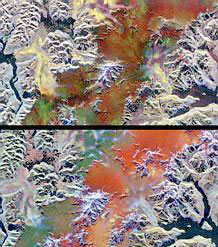
Large Ice
Fields The Patagonian Glaciers, these two radar images
were taken five and a half months apart by Space Shuttle
Endeavour. |
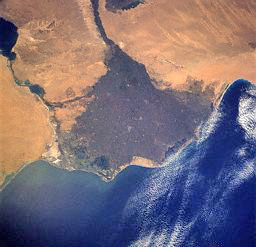
Views from
Space of Nile River
|
|

Views from
Space of Nile River |
|

Indus River
|

Indus River
|
|

Euphrates
crossing Syria |

Euphrates
crossing Turkey |
|
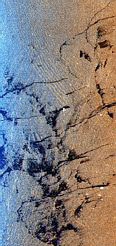
Oil Spills
in the Arabian Sea |

Persian Gulf
seen from Space
|

Northern end
of Persian Gulf, seen from Space
|
|
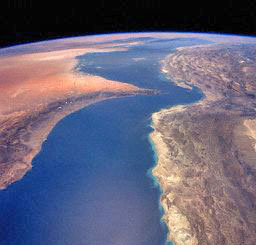
Persian Gulf
, Gulf of Oman and the Strait of Hormuz, from Space |

Lower Pool
of Jerusalemís Gihon Spring |
|

The
Arabian Sea spans the Horizon from the western part of
Pakistan. |
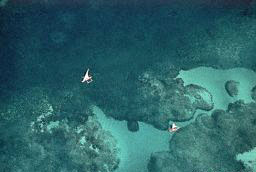
Indian
Ocean off Kenya
. |
|
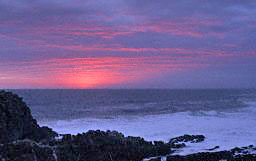
Sunset
over Indian Ocean
.
|

Wall of
Babylonian Archaeological Ruins.
Capital of the former Mesopotamian Empire |
Earth Station
I....Work on the Land.... Nippur, Mission Control Site ....
Sophisticated Instruments and Weapons....
"At Eridu, in southern Mesopotamia, the
Nefilim established Earth
Station I, a lonely outpost on a half-frozen planet.
"....A Sumerian text, believed to have been the original of the
Akkadian "Deluge," relates the following regarding five of the first
seven cities:
Only part of the text given here:
The first of the cities, ERIDU,
he gave to Nudimmud, the leader,
The second, BAD-TIBIRA,
he gave to Nugig.
The third, LARAK,
he gave to Pabilsag.
The fourth, SIPPAR,
he gave to the hero, Utu.
The fifth, SHURUPPAK,
he gave to Sud.
"The name of the god who lowered Kingship from Heaven, planned the
establishment of Eridu, and four other cities, and appointed their
governors or commanders, is unfortunate obliterated. All the texts
agree, however, that the god who waded ashore to the edge of the
marshlands and said: "Here we settle" was Enki, nicknamed "Nudimmud"
("he who made things") in the text.
"This godís two names -
EN.KI ("lord of firm ground") and E.A
("whose house is water") - were most appropriate.
Some of the works performed on the land and water were:
the cleaning of the small rivers,
drain the marshes,
obtain cleaner, potable water,
implement controlled irrigation
landfillings or the raising of dikes to protect the first houses
from the omnipresent waters.
Many other works were recorded in a poem: here are some:
He marked the marshland,
placed in it carp . . . - fish;
He marked the cane thicket,
placed in it . . . - reeds and green-reeds.
Enbilulu, the Inspector of Canals,
he placed in charge of the marshlands.
Him who set net so no fish escapes,
whose trap no . . . escapes,
whose snare no bird escapes,
...the son of . . . a god who loves fish
Enki placed in charge of fish and birds.
Enkimdu, the one of the ditch and dike,
Enki placed in charge of ditch and dike.
Him whose . . . mold directs,
Kulla, the brick maker of the Land,
Enki placed in charge of mold and brick.
"....The
Sumerian king lists indicate that
Enki and his first group
of Nefilim remained alone on Earth for quite a while: Eight sharís
(28,000 years) passed before the second commander or "settlement
chief was named."
"Interesting light is shed on the subject as we examine the
astronomical evidence.
A serious study is also offered taking in consideration the passing
of the constellations. Mr. Sitchin continues:
"If Enki landed on Earth - as we believe - at the start of an
Age of Piscis, witnessed a precessional shift to Aquarius, and stayed
through a Great Year (25,920 years) until an age of Capricorn began,
then he was indeed in sole command on Earth the purported 28,000
years.
The book continues with more study and conclusions.
"But while Enki was enduring the hardships of a pioneer on Earth,
Anu and his other son Enlil were watching the developments from the
Twelfth Planet. The Mesopotamian texts make it clear that the one
who was really in charge of the Earth Mission was Enlil; and as soon
as the decision was made to proceed with the mission, Enlil himself
descended to Earth. For him a special settlement or base named
Larsa
was built by EN.KI.DU.NU ("Enki digs deep"). When
Enlil took
personal charge of the place, he was nicknamed ALIM ("ram"),
coinciding with the "age" of the zodiacal constellation Aries.
"....Larsa launched a new phase in the settlement of Earth by the
Nefilim. It marked the decision to proceed with the tasks for which
they had come to Earth, which required the shipping to Earth of more
"manpower," tools, and equipment, and the return of valuable cargoes
to the Twelfth Planet."
"....From
Larsa Enlil proceeded to establish a "Mission Control
Center" - a sophisticated command post from which the
Nefilim from
Earth could coordinate space journeys to and from their home planet.
"....The site Enlil selected for this purpose, known for millennia
as Nippur, was named by him NIBRU.KI ("Earthís crossing").
Sophisticated instruments in Nippur:
"...a "lifted
íeyeí which scans the land"
"...a "lifted beam which searches the heart of all the land."
Awesome weapons:
"....Its sight is awesome fear, dread"; from "its outside no mighty
god can approach." Its "arm" was a "vast net," and in its midst
there crouched a "fast-stepping bird," a "bird" whose "hand" the
wicked and the evil could not escape. Was the place protected by
some death ray, by an electronic power field? Was there in its
center a helicopter pad, a "bird" so swift no one outrun its reach?
Other features were:
".... the dark, crownlike chamber"....where stars charts were kept;
where the astronaut's communications were received and instructed
from.
"....Archaic Sumerian pictographs show a structure of a high tower
of antennas rising from it, as well as a contraption that looks very
much like the giant radar nets erected nowadays for capturing and
emitting signals - the "vast net" described in the texts.
|

Marshland in
Africa
Enki..... marked the marshland..... as mentioned in The
12th Planet.... |

Areal view
of a Marshland |
|

Sculpture of
man holding a carp.
Prague, Czechoslovakia.
It brings to mind.... (Enki) placed carp in the marsh as
the poem in the book says.... |
|

Reeds, left
and lower. |

He.... (Enki).... placed
in it (the marsh) reeds.... |
|
 |

Enlilís
"awesome weapons," are likened to Radar and Radio
Dishes, "the net" in whose center there appeared to be
like the likeness of a "fast-stepping bird." |
|

Radio Dish |

Radio Dish |
The Spaceport at Sippar....The ancient symbol of "Target"
"While these centers were being established (the seven cities),
the completion of Nippur was followed by the construction of the
spaceport of the Nefilim on Earth. The text made clear that
Nippur
was the place where the "words" - commands - were uttered: There,
when Enlil commanded: "Towards Heaven!"... that which shines forth
rose like a sky rocket." But the action itself took place "where
Shamash rises," and that place - the "Cape Kennedy" of the
Nefilim -
was Sippar, the city in the charge of the Chief of the Eagles,
(Shamash, Enlilís grandson) where multistage rockets were raised
within its special enclave, the "sacred precinct."
"Completing the list of the first seven cities of the Gods and the
correspondence with the twelve zodiac constellations was Larak,
where Enlil put his son Ninurta in command. The city list calls him
PA.BIL.SAG ("great protector"); it is the same name by which the
constellation Sagitarius was called.
"It would be unrealistic to assume that the
first seven Cities of
the Gods were established haphazardly. These "gods" who were capable
of space travel, located the first settlements in accordance with a
definite plan, serving a vital need: to be able to land on Earth and
to leave Earth for their own planet.
"What was the master plan?
"As we searched for an answer, we asked ourselves a question: What
is the origin of Earthís astronomical and astrological symbol, a
circle bisected by a right-angle cross - the symbol we use to
signify "target."
The symbol goes back to the origin of astronomy and astrology in
Sumer and is identical with the Egyptian hieroglyphic sign for
"place."
"Is this a coincidence, or significant evidence? Did the
Nefilim
land on Earth by superimposing on its image or map some kind of
"target"?
Mr. Sitchin explains that
Mt. Ararat, from which two picks arise,
Little Ararat and Great Ararat, like two shining beacons,
permanently snow-covered, plus other features in the surrounding
areas, served the Nefilim as landing site; plus coordinations of
south-north meridian, and the convenience of a river location.
"....A meridian drawn through the center of the twin-peaked
Ararat
bisected the Euphrates. That was the target - the site selected for
the space port.
Explaining the possibilities,
Mr. Sitchin confirms three questions:
To the question of "could one easily land and take off there? The
answer was Yes.
"Could astronauts and materials be brought there without too much
difficulty? The answer was Yes.
"Was there a nearby source of energy, of fuel for light and power?
The answer was an emphatic Yes.
"The bend in the Euphrates River where
Sippar was to be established
was on of the richest known sources in antiquity of surface bitumens,
petroleum products that seeped up through natural wells and could be
collected from the surface without any deep digging or drilling.
"In Near Eastern languages, the name, Sippar, means "bird."
Sippar
was the place where the Eagles would come to nest.
"How would the space shuttles glide down to
Sippar?
By navigation, using the familiar Earth features, which had in fact
had been:
|
click to enlarge

Cuneiform
Planisphere
Nineveh, Assyria
British Museum |
"drawn on a ceramic unearthed at
Susa, in a stratum dated to about
3,200 B.C. This shows:
"A triangle of waters and mountains on each side, pointing like an
arrow toward Sippar. An "X" would mark Nippur, in the center.
"It brings to mind the planisphere that described the flight path
and procedures, which was based on 45-degree segments.
Because the ceramic of the "Target" is so incredible,
Mr. Sitchin
explains:
"Incredible as it may seem, this sketch was not made by us...."
"...This we believe, was the master plan of the Nefilim. Having
selected the best location for their spaceport (Sippar), they laid
out the other settlements in a pattern outlining the vital flight
path to it. In the center they placed Nippur, where the "bond
Heaven-Earth" was located"
|

TARGET -
This photo is of the Space Station Mir. But the symbol
of "target," the "cross" in the center for docking, is
exactly the same used in the ancient charts for landing,
found at Susa, and believed to have belonged to Enlil
and the "astronauts" under Enlilís command.
|
|
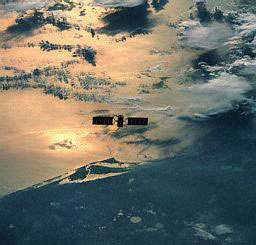
View of
satellite Eureka as it flies over Cape Canaveral
(Kennedy Space Center), taken from shuttle Atlantis.
It reminds of what is found in The 12th Planet:
"Enlil
commanded "Toward Heaven"; that which shines forth rose
like a sky rocket...." |

Rockets on
display. Kennedy Space Center, Florida
. |
Ark of the
Covenant.... "Black Boxes" .... Ziggurats....
Mr. Sitchin takes times to explain the many instruments the
Sumerians had possessed in their Spaceport and at the "Mission
Control" in Nippur.
Some of these instruments bring to mind the Ark of the Covenant.
Mr. Sitchin comments:
"...These "black boxes", when we see what they look like, bring to
mind the Ark of the Covenant built by Moses under Godís
instructions. The chest was to be made of wood, overlaid with gold
both inside and outside - two electricity-conducting surfaces were
insulated by the wood between them. A kapporeth, also made of gold,
was to be placed above the chest and held up by two cherubim cast of
solid gold. The nature of the kapporeth (meaning, scholars speculate
"covering") is not clear; but this verse from Exodus suggests its
purpose: "And I will address thee from above the Kapporeth, from
between the two Cherubim."
"The implication that the
Ark of the Covenant was principally a
communication box, electrically operated, is enhanced by the
instructions concerning its portability. It was to be carried by
means of wooden staffs passed through four golden rings. No one was
to touch the chest proper; and when one Israelite did touch it he
was killed instantly - as if by a charge of high-voltage
electricity.
"Such apparently supernatural equipment - which made it possible to
communicate with a deity though the deity was physically somewhere
else - became objects of veneration, "sacred cult symbols." Temples
at Lagash, Ur, Mari, and other ancient sites included among their
devotional objects "eye idols." The most outstanding example was
found at an "eye temple" at Tell Brak, in northwestern Mesopotamia.
This fourth-millennium temple was so named not only because hundreds
of "eye" symbols were unearthed there but mainly because the
templeís inner sanctum had only one altar, on which a huge stone
"double eye" was displayed.
"In all probability, it was a simulation of the actual divine object
- Ninurtaís "terrible eye," or the one at Enlilís
Mission Control
Center at Nippur, about which the ancient scribe reported: "His
raised eye scans the land ... His raised Beam searches the land."
Mr. Sitchin continues on to explain the building of the
ziggurats,
their measurements, and the probable relation with the distances and
locations of the Cities of the Gods.
He continues:
"But were the
ziggurats raised only to observe the stars and
planets, or were they also meant to serve the spacecraft of the Nefilim? All the
ziggurats were oriented so that their corners
pointed exactly north, south, east, west. As a result, their sides
run precisely at 45-degrees angles to the four cardinal directions.
This meant that a space shuttle coming in for a landing could follow
certain sides of the ziggurat exactly along the flight path - and
reach Sippar without difficulty.
"....Even scholars who have approached the subject without our
"space" interpretation could not escape the conclusion that the
ziggurats had some purpose other than to make the godís abode a
"high rise" building. Samuel N. Kramer summed up the scholastic
consensus: The ziggurat, the stagetower, which became the hallmark
of Mesopotamian temple architecture ... was intended to serve as a
connecting link, both real and symbolic, between the gods in heaven
and the mortals on earth.
"We have shown, however, that the function of these structures was
to connect the gods in Heaven with the gods - not the mortals - on
Earth"
Return
|




























